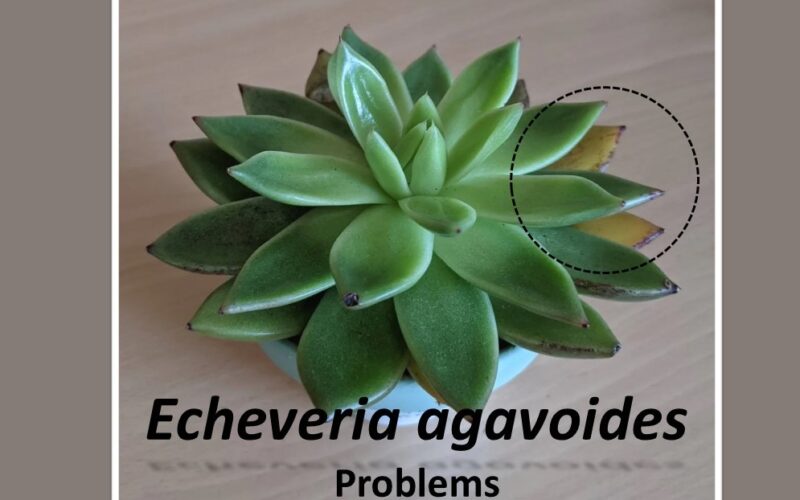Unfit taking care of Echeveria agavoides like overwatering, underwatering, or low light will cause Echeveria agavoides yellow leaves, although intense direct sunlight will lead to Echeveria agavoides sunburn. Anyway, pests like Mealybugs, Scale, Aphids, and Spider mites and diseases such as root rot, crown rot, and powdery mildew will produce Echeveria agavoides problems too.
Hi, I’m a horticultural consultant who in this post wants to tell you about common problems you may encounter while caring for Echeveria agavoides. Here, I will tell you about the signs and symptoms of every above problem and show you how to fix and treat it based on my experiences.
In addition, I will show you how to prevent these Echeveria agavoides problems. I also provide a guideline for caring for Echeveria agavoides. By following my tips, you will enjoy the beauty of your Echeveria agavoides for years to come.
Keep reading to find out why your plant is sad. If you cannot find it here, please tell me in the comments, and I will help you. let’s get going.
Echeveria agavoides: A Waxy Beauty
Echeveria agavoides is commonly known as Wax Echeveria, Wax Agave, Molded Wax Plant, and Molded Wax Agave. These names refer to the plant’s waxy, sculpted appearance. Here, I will speak with you about its appearance and benefits.
Appearance
Echeveria agavoides is a striking succulent that lives up to its common name, “Wax Echeveria.” Its rosette-shaped form is composed of thick, fleshy leaves that often have a pointed tip resembling an agave plant’s. The leaves are typically a bluish-green colour, but can vary depending on the specific cultivar. Many varieties develop reddish tips or edges when exposed to ample sunlight.
Benefits
While primarily admired for its aesthetic appeal, Echeveria agavoides, like other succulents, offers some indirect benefits:
- Air purification: Like many plants, it contributes to improving indoor air quality by absorbing carbon dioxide and releasing oxygen.
- Low maintenance: As a succulent, it’s drought-tolerant and requires minimal care, making it ideal for busy people or those with limited gardening experience.
- Aesthetic appeal: Its unique appearance adds a touch of natural beauty to any indoor or outdoor space.
- Stress reduction: Studies have shown that interacting with plants can reduce stress and improve mood.
It’s important to note that the primary benefit of Echeveria agavoides is its ornamental value. While it contributes to air purification, its impact is relatively small compared to larger plants or specialized air-purifying varieties.
Echeveria agavoides Problems
Echeveria agavoides yellow leaves

Yellowing leaves on your Echeveria agavoides can be a cause for concern, but it’s often a sign of an easily correctable issue. Here are some common reasons and treatments:
Common Causes of Yellow Leaves:
Overwatering:
This is the most common culprit. Echeverias are succulents and prefer their soil to dry out completely between waterings. Signs of overwatering include soft, mushy leaves and potential root rot.
Treatment: Allow the soil to dry out completely before watering again. Consider repotting if the roots are severely damaged.
Underwatering:
While less common, underwatering can also cause yellow leaves. Leaves will appear shrivelled and dry.
Treatment: Increase the frequency of watering, but ensure proper drainage.
Improper Lighting:
Echeverias need bright, indirect light. Too little light can lead to elongated growth and yellowing leaves.
Treatment: Move your plant to a location with more light.
Root Bound:
If your Echeveria has been in the same pot for too long, its roots may become overcrowded. This can restrict nutrient and water uptake, leading to yellow leaves.
Treatment: Repot your plant into a larger pot with fresh, well-draining soil.
Natural Aging:
Older leaves may naturally yellow and die as the plant grows. This is a normal process.
Treatment: Remove the yellow leaves to prevent rot.
My Additional Tips for Echeveria agavoides yellow leaves
- Check for pests: Mealybugs or scale can cause yellowing leaves. If you suspect a pest infestation, treat your plant accordingly.
- Avoid fertilizing too often: Over-fertilization can lead to salt buildup and yellow leaves.
- Ensure proper drainage: Use a well-draining potting mix to prevent waterlogged soil.
Echeveria agavoides Sunburn

Sunburn is a common issue with Echeveria agavoides, especially during the intense summer months. These succulents love bright light, but too much direct sunlight can cause damage.
Symptoms of Echeveria agavoides Sunburn
- Brown or reddish patches on the leaves
- Yellowing or wilting of leaves
- In severe cases, the leaves may become crispy and dry
Preventing Echeveria agavoides Sunburn
- Gradual Acclimation: If you’re moving your plant to a sunnier spot, gradually increase its exposure to prevent shock.
- Bright, Indirect Light: Ideally, your Echeveria should receive bright, indirect sunlight.
- Shade During Peak Hours: If you live in a region with intense sunlight, provide shade during the hottest part of the day.
Treating Echeveria agavoides Sunburn
- Move to Shadier Location: Immediately relocate your plant to a spot with less direct sunlight.
- Patience: The sunburned parts of the leaves won’t recover, but new growth should be healthy if you provide the right conditions.
- Remove Severely Damaged Leaves: If the leaves are severely damaged, you can remove them to prevent rot.
I always say prevention is key. By understanding your plant’s light needs and providing adequate protection, you can avoid sunburn and keep your Echeveria thriving.
Pests and Diseases of Echeveria agavoides
While Echeveria agavoides is relatively resilient, it can still fall victim to pests and diseases. Here are some essential tips.
Common Pests of Echeveria agavoides
Mealybugs

These tiny, white insects look like cotton balls and often hide in leaf axils. They suck sap from the plant, causing yellowing leaves and stunted growth. you may spot them in roots too (root Mealybugs).
Treatments:
- Manual removal: For small infestations, use a cotton swab dipped in rubbing alcohol to remove individual mealybugs.
- Insecticidal soap: Spray the entire plant with a diluted insecticidal soap solution. Repeat as needed.
- Neem oil: A natural and effective option. Mix Neem oil with water according to package instructions and spray the plant thoroughly.
Scale Insects
Similar to mealybugs, scale insects attach themselves to the plant and feed on its sap. They can be difficult to spot as they often blend in with the plant.
Treatment:
- Manual removal: Scrape off scale insects with a toothbrush or your fingernails.
- Isopropyl alcohol: Apply rubbing alcohol to the insects with a cotton swab.
- Horticultural oil: Spray the plant with a diluted horticultural oil solution.
Aphids
These small, soft-bodied insects can infest your Echeveria, causing distorted growth and leaf yellowing.
Treatment:
- Strong water spray: Blast aphids off the plant with a strong stream of water.
- Insecticidal soap: Spray the plant with a diluted insecticidal soap solution.
- Neem oil: Apply neem oil according to package instructions.
Spider Mites
These tiny pests create webs on the plant and suck sap, leading to yellowing and brown spots on leaves.
Treatment:
- Increase humidity: Spider mites thrive in dry conditions. Increase humidity around your plant by misting or using a humidity tray.
- Insecticidal soap: Spray the plant thoroughly with insecticidal soap.
- Miticide: For severe infestations, use a miticide specifically designed for spider mites.
Common Diseases of
Echeveria agavoides
Root Rot

Caused by overwatering, root rot is a fungal disease that can quickly kill your plant. Symptoms include soft, mushy stems and leaves.
Treatments:
- Repotting: Remove the plant from the pot, carefully clean the roots, and repot in fresh, well-draining soil.
- Fungicide: Apply a fungicide to the roots before repotting.
Crown Rot
Similar to root rot, crown rot affects the base of the plant. It causes the plant to become soft and watery.
Treatments:
- Cuttings: If the crown rot hasn’t spread too far, you may be able to save the plant by taking healthy cuttings.
- Fungicide: Apply a fungicide to the affected area, but it’s often difficult to save the plant.
Powdery Mildew

A fungal disease that appears as a white powdery substance on leaves. It can cause leaves to yellow and drop.
Treatments:
- Improve air circulation: Ensure good airflow around your plant.
- Fungicide: Apply a fungicide specifically for powdery mildew.
Prevent Echeveria agavoides problems
As I told you before, prevention is key. Providing your Echeveria with the proper care, including adequate light, drainage, and watering, can help prevent pests and diseases. Preventing pests and diseases is crucial for the health of your Echeveria agavoides. I first tell you about general things you must consider to prevent Echeveria agavoides problems:
- Regular Inspection: Regularly check your Echeveria for signs of pests or diseases.
- Proper Watering:
- Good Drainage: Ensure your plant has well-draining soil.
- Isolation: If you suspect a pest or disease, isolate the affected plant to prevent spreading.
- Proper Watering: Ensure your plant has good drainage and avoid overwatering to prevent root rot.
- Sufficient Light: Provide ample, indirect light for optimal plant health.
- Good Air Circulation: Improve airflow around your plant to reduce the risk of fungal diseases.
Pest Prevention in Echeveria agavoides
- Quarantine New Plants: Isolate new plants for some time to ensure they are pest-free before introducing them to your collection.
- Cleanliness: Keep your plants and their surroundings clean. Remove dead leaves and debris promptly.
- Natural Predators: Encourage beneficial insects like ladybugs and lacewings, which can help control pest populations.
Disease Prevention in Echeveria agavoides
- Sterilize Pots and Tools: When repotting or propagating, sterilize your pots and tools to prevent the spread of diseases.
- Avoid Overwatering: Excessive moisture can create ideal conditions for fungal diseases.
- Proper Drainage: Ensure your plant has well-draining soil to prevent waterlogged roots.
Caring for Echeveria agavoides
Echeveria agavoides, often called the Wax Echeveria, is a stunning succulent with thick, fleshy leaves. Here’s a breakdown of its care requirements:
Light
- Bright, indirect light: This is ideal for bringing out the plant’s vibrant colours.
- Tolerates full sun: But be cautious during the intense summer heat, as sunburn can occur.
- Avoid shady areas: These can lead to elongated growth and reduced colour intensity.
Watering of Echeveria agavoides
- Less is more: Echeverias are drought-tolerant and prefer their soil to dry out completely between waterings.
- Soak and dry method: Water deeply when you do water, allowing the soil to dry out completely before watering again.
- Avoid overhead watering: This can lead to rot in the center of the rosette.
Soil
- Well-draining soil: Essential to prevent root rot. A succulent or cactus mix works well.
- Perlite or pumice: Adding these to the soil improves drainage.
Temperature
- Warm temperatures: Echeverias prefer temperatures between 60-75°F (15-24°C).
- Tolerate cooler temperatures: But protect from frost.
Humidity
- Low to medium humidity: High humidity can lead to fungal diseases.
Fertilizing of Echeveria agavoides
- Sparse feeding: Feed during the growing season (spring and summer) with a diluted succulent fertilizer.
- Avoid over-fertilizing: This can lead to salt buildup and root damage.
Repotting
- Repot when necessary: Repot when the plant becomes rootbound or the soil is depleted.
- Spring or early summer: The best time for repotting.
- Use a well-draining pot: A terracotta pot is a good choice.
Propagation of Echeveria agavoides
- Leaf cuttings: A common method for Echeveria propagation.
- Offset pups: Some varieties produce offsets that can be separated and rooted.
Conclusion
I gave you a comprehensive guideline to detect and fix your Echeveria agavoides problems. I showed you Echeveria agavoides yellow leaves, sunburn, root rot, crown rot, powdery mildew, Mealybugs, Scale, Aphids, and Spider mites can bring about problems.
Now, you know how to treat every above problem and find out by following some general prevention tips like air circulation, proper watering, and regular inspection can barricade these problems. Although I told you specific ways to hamper every pest and disease.
Could you find your Echeveria agavoides problems here? Do you think my treatments can work well? I avoided to mentione chemical pesticides or fungicides due to respect to the environment although sometimes using them is inevitable.
You can ask me your questions below this page, however, can find me on Instagram too.

Elahe Rabiei
Hi, I’m Elaheh. My Academic major is plant protection, and houseplants are my expertise. As a houseplant lover, my house is full of indoor plants and it is my passion to take care of them. Hence, I’m here to share my knowledge and experience about growing healthy houseplants. I am also a plant protection advisor, so feel free to ask me any questions you may have.

